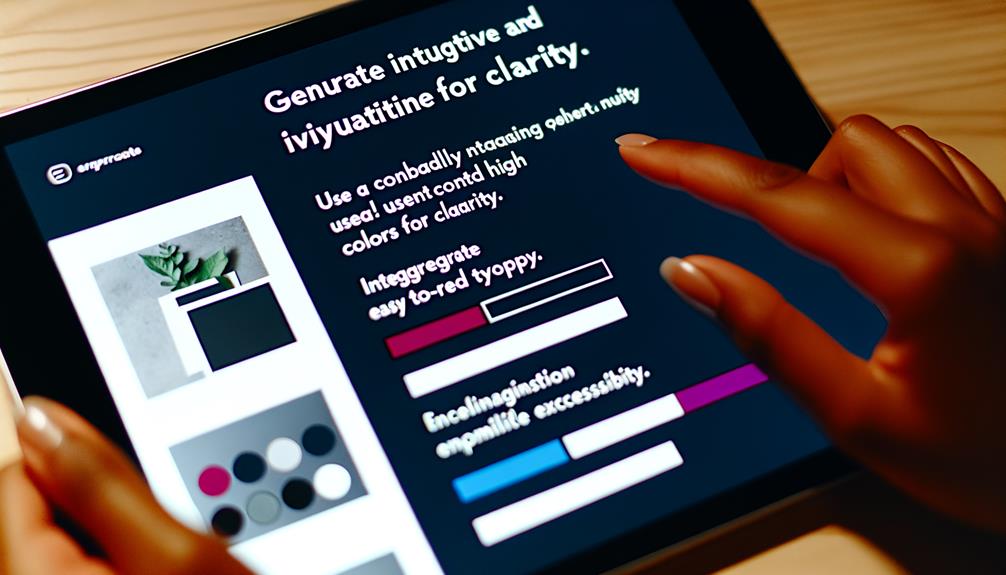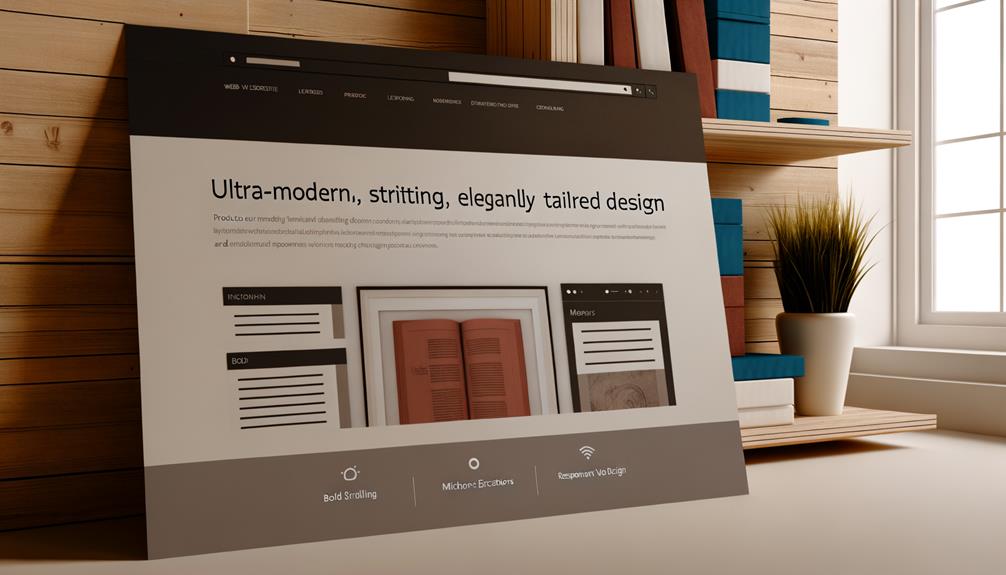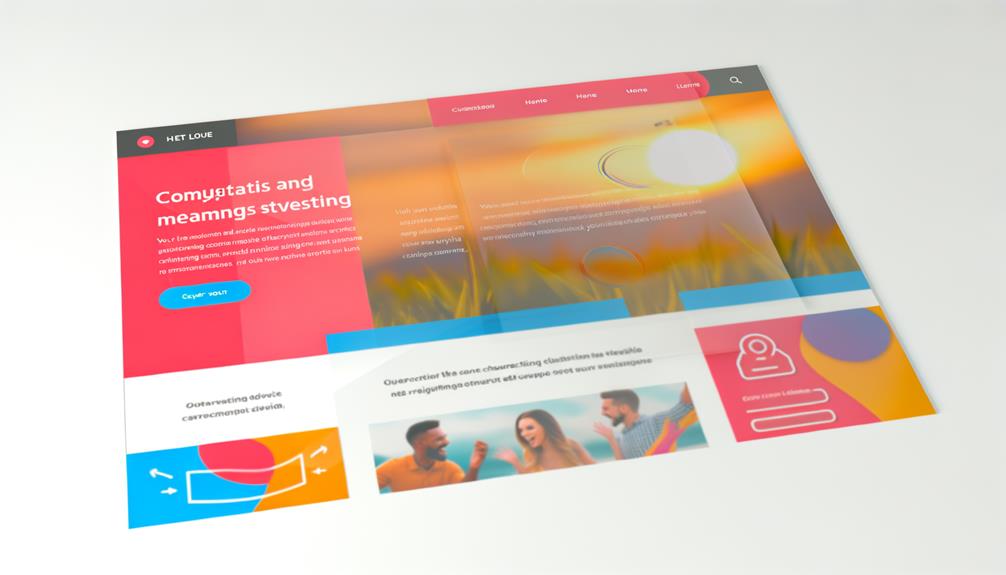As we enter 2023, an impressive 75% of website credibility comes from its design. The world of web design is constantly evolving, and it's crucial for professionals to stay informed about the latest trends and strategies.
In this comprehensive guide, we will unravel the intricate web design landscape, uncovering the fundamental principles, user-centric approaches, and innovative techniques that will set the stage for impactful online experiences.
So, what does it take to create a captivating and effective web design in 2023? Let's explore the strategic elements and best practices that will elevate your digital presence and engage your audience in a meaningful way.
Understanding Web Design Fundamentals

Understanding web design fundamentals is essential for creating impactful and user-friendly digital experiences that resonate with our audience and drive success. It's the backbone of every website, blending creativity and functionality to captivate users. By grasping the basics, we gain the power to shape engaging online journeys.
From defining goals and understanding our audience to choosing the perfect color palette and planning site architecture, these fundamentals pave the way for a compelling web presence. Integrating SEO, prioritizing user experience, and staying adaptable are crucial best practices.
Embracing these principles empowers us to navigate the intricate web design landscape and craft websites that stand out. Let's embark on this journey together, armed with the knowledge to create impactful digital experiences.
Incorporating User-Centric Design Principles
Incorporating user-centric design principles ensures that our websites prioritize the needs and preferences of our audience, ultimately leading to enhanced engagement and satisfaction. By focusing on the user experience, we can create more intuitive and effective designs. Here are three key user-centric design principles to consider:
| Principle | Description | Benefits |
|---|---|---|
| User Research | Conduct thorough research to understand the audience's behaviors and needs. | Tailored designs, higher engagement |
| Usability Testing | Test the website with real users to identify and address usability issues. | Improved user experience |
| Personalization | Customize content and features based on user preferences and interactions. | Enhanced user satisfaction |
Implementing SEO Strategies for Web Design

Implementing SEO strategies in web design enhances discoverability and drives organic traffic to your website, boosting its online visibility and reach. By incorporating relevant keywords, optimizing meta tags, and creating high-quality, shareable content, your website becomes more search engine friendly. This strategic approach not only improves your site's ranking on search engine results pages but also ensures that it aligns with user search intent.
Additionally, optimizing website speed, creating mobile-friendly designs, and enhancing user experience contribute to higher search rankings. Implementing structured data markup further enhances your site's appearance in search results, increasing the likelihood of attracting clicks.
Navigating the Evolving Web Design Landscape
The dynamic nature of web design continually shapes the digital landscape, influencing user experiences and online interactions. As designers, we must stay adaptable and embrace change to create compelling and effective websites.
With technological advancements and shifting user behaviors, it's crucial to prioritize continuous learning and evolution in our approach. This means keeping abreast of emerging design trends, new tools, and best practices. By doing so, we empower ourselves to craft innovative, user-centric designs that stand out in the ever-changing digital realm.
Embracing the evolving web design landscape not only ensures relevance but also opens doors to new creative possibilities. Let's navigate this dynamic terrain together, leveraging it to create impactful digital experiences for our audience.
Creating Engaging and Accessible Web Content

As we navigate the evolving web design landscape, our focus now turns to crafting engaging and accessible web content that captivates and resonates with our audience. When creating web content, it's essential to ensure it is both visually appealing and easily accessible to all users. Here's a table summarizing key strategies for creating engaging and accessible web content:
| Strategies for Engaging and Accessible Web Content |
|---|
| 1. Use high-quality visuals and multimedia |
| 2. Prioritize clear and concise language |
| 3. Implement alt text for images and descriptive |
| captions for multimedia content |
Leveraging Technology for Innovative Web Design
Utilizing cutting-edge technology enhances the user experience and empowers web designers to create innovative and dynamic online platforms. AI and machine learning can personalize content and streamline navigation, while AR and VR offer immersive experiences. Responsive design, powered by advanced CSS and JavaScript frameworks, ensures seamless functionality across devices.
Integrating chatbots and voice interfaces improves accessibility and interactivity. Embracing progressive web apps and accelerated mobile pages enhances speed and performance. Leveraging data analytics and user behavior tracking drives informed design decisions. By harnessing these technologies, web designers can push boundaries, captivate audiences, and stay ahead in the ever-evolving digital landscape.
Embracing technology liberates creativity, enabling us to craft unparalleled web experiences that resonate with modern users.
Optimizing Web Design for Multi-Device Compatibility

Embracing a multi-device compatible approach in web design is essential for engaging and retaining diverse user audiences. By prioritizing multi-device compatibility, we liberate users from the constraints of traditional desktop-centric design. Our goal is to provide a seamless and optimized experience across various devices, empowering users to access our content on their terms.
Responsive design techniques, such as flexible grids and media queries, enable us to adapt our websites to different screen sizes and orientations. This ensures that our design remains visually appealing and fully functional, regardless of the device being used.
Ensuring Seamless User Experience With Ui/Ux Design
Prioritizing multi-device compatibility in web design has empowered us to expand our reach and enhance user satisfaction. Now, we delve into ensuring a seamless user experience through Ui/Ux design. To achieve this, we focus on:
- Intuitive Navigation: Seamlessly guide users through the website, empowering them to find what they need effortlessly.
- Engaging Visuals: Captivate and inspire users through visually appealing and purposeful design elements.
- Streamlined Interactions: Ensure that every interaction with the website is smooth and efficient, keeping users engaged and satisfied.
Staying Ahead With Web Design Trends and Best Practices

Staying abreast of current web design trends and best practices is essential for creating impactful and successful digital experiences. By embracing emerging trends and adopting best practices, we can ensure that our websites remain relevant and engaging.
Incorporating cutting-edge techniques such as micro-interactions, immersive storytelling, and minimalist design can captivate users and set our websites apart. Additionally, prioritizing accessibility, inclusivity, and sustainability in our designs demonstrates a commitment to social responsibility and enhances the overall user experience.
Embracing new technologies like AI-powered chatbots and voice user interfaces can also elevate the functionality and convenience of our websites. By staying ahead of web design trends and best practices, we can position ourselves as innovators in the digital space and deliver exceptional experiences to our audiences.
Frequently Asked Questions
How Can Web Design Contribute to a Brand's Overall Marketing Strategy?
Web design contributes to a brand's marketing strategy by shaping its online presence and user experience. It captivates and engages visitors, reinforcing brand identity and values. Through strategic design choices, we enhance brand recognition and trust, driving conversions and customer loyalty.
Our web design ensures seamless navigation and showcases the brand's uniqueness, leaving a lasting impression on visitors. It's a powerful tool for amplifying our brand's impact in the digital landscape.
What Are Some Common Challenges Faced by Web Designers When Creating Accessible Web Content?
We encounter various challenges when crafting accessible web content. Ensuring compatibility across devices and screen readers demands meticulous attention.
Balancing aesthetics and functionality while adhering to accessibility guidelines can be complex. We prioritize user experience, striving to make content perceivable, operable, and understandable for all.
Our commitment to inclusivity drives us to conquer these challenges and deliver web experiences that resonate with everyone.
How Can Web Designers Leverage Emerging Technologies to Enhance User Experience?
We can leverage emerging technologies to enhance user experience by:
- Integrating AI for personalized recommendations
- Implementing AR/VR for immersive interactions
- Optimizing for voice search
These advancements can:
- Elevate engagement
- Streamline navigation
- Offer unique interactive elements
By embracing innovation, we ensure our websites remain cutting-edge and user-centric, setting us apart in the digital landscape.
Embracing these technologies will propel our designs into the future, enhancing user experiences to new heights.
What Are Some Key Considerations for Optimizing Web Design for Multi-Device Compatibility?
We prioritize multi-device compatibility by ensuring seamless experiences across all platforms. Understanding diverse user behaviors and needs guides our design choices.
We integrate responsive design principles, optimizing content and navigation for various screen sizes. This approach guarantees accessibility and engagement. By embracing adaptability, we create captivating and functional websites for all users.
Our strategy focuses on delivering exceptional experiences regardless of the device, enhancing user satisfaction and retention.
What Are Some Upcoming Web Design Trends That Designers Should Be Aware of for 2023?
We're keeping an eye on upcoming web design trends for 2023. Embracing neumorphism, 3D elements, and immersive experiences are key.
Personalization, inclusivity, and sustainability will shape the design landscape. Our goal is to stay ahead, creating captivating and purposeful websites.
We'll prioritize user-centric design, seamless interactions, and cutting-edge visuals. It's an exciting journey, and we're committed to crafting innovative web experiences for the future.
Conclusion
Join us in embracing the dynamic world of web design.
By prioritizing user-centric design, staying updated with SEO strategies, and leveraging innovative technology, we can create impactful online experiences.
Let's adapt to the evolving web design landscape and ensure seamless multi-device compatibility.
Together, we can elevate our skills, stay ahead of trends, and craft engaging web content.
Let's make 2023 the year of exceptional web design.







